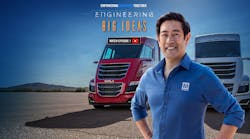Grant Imahara takes an in-depth look at the ideation process, learning how an idea moves from a sudden spark of innovation to a tangible, finished product. He interviews Nikola CEO Trevor Milton and discusses the road they took when engineering their big idea into tomorrow's tech.
Keep on Trucking, but in an Environmentally Friendly Way
Reducing the environmental impact of the long-haul trucking industry is a top priority across the planet. Within the United States, some states are now considering implementing emissions-reduction legislation similar to what Europe has already mandated. Fossil fuels are the targets of these emission-reduction initiatives, so most major vehicle manufacturers are embarking on electric-vehicle (EV) design programs.
Using environmentally clean zero-emission electric motors as the primary alternative to diesel engines may seem an obvious option. Finding an efficient and affordable battery technology to power semi-trucks has remained elusive, though. Not only that, implementing from scratch the EV charging station infrastructure necessary for fueling long-haul semi-trucks has provided a further challenge to motor manufacturers that, in the past, have never had to worry about building a network of locations for vehicles to refuel.
Are electric-powered semi-trucks the best alternative for reducing hazardous emissions? As companies started development, it seemed so at first. Battery research, electric-motor design, and EV drive-train controller technologies steadily advanced year after year, and before long, light trucks with electric motors started to take shape.
Initially, local delivery vans based on existing car platforms quickly came to market and proved extremely popular for use in inner-city zero-emission zones. However, several forward-thinking individuals could see the time when large semi-trucks with their high-capacity diesel engines would be subject to increasing environmental pressures and legislation—and they were aware of the limitations of current electric-motor technologies for powering long-haul trucks. The race was on to deliver a commercially viable and zero-emission alternative semi-truck to fleet operators who were already becoming concerned about how impending “green” regulations would impact their business.
Nikola’s Big Idea
Trevor Milton, founder and CEO of Nikola Motor Company, is an entrepreneur driven by an ambition to build a zero-emission Class 8 truck. His 37-metric-ton idea was to design and produce an innovative semi-truck along with a sustainable way of keeping it running. Aware that diesel-truck operators not only have to pay for their trucks but also shell out a considerable amount of money to keep them fueled, he wanted to find a way to provide significant cost savings while achieving zero emissions.
Milton’s thinking led him down a completely new road: a truck powered by electricity created using a hydrogen fuel cell. This approach gains a significant weight advantage compared to an electric semi using batteries. Nikola’s Tre truck typically has a 750-mile range, but weighs less than the batteries of an EV equivalent. Also, hydrogen is readily produced, and the only emission resulting from the electrochemical reaction is water.
Further, refueling a hydrogen cell takes only 15 minutes, compared to many hours to fast-charge batteries, thus saving considerable off-road time on long hauls. Hydrogen is a clear winner when it comes to operating efficiency over medium to long hauls due to the design being lighter, improving the freight-ton per mile ratio.
On top of that, Milton’s big idea also had to include a national infrastructure of hydrogen fueling stations to supply the truck with a million miles of fuel. Without a dependable network to refuel, Nikola wasn't going anywhere. The formula has proved successful, with $14 billion of preorders; for the moment, Nikola has stopped taking orders to focus on production.
Innovation in Action at Nikola
Nikola believes that most of the greatest innovations do not come from big companies. As Nikola President Mark Russell states, “It's easier to be the disruptor than the companies being disrupted.”
The company recognizes that agility and close working relationships with supply-chain partners are crucial to maintaining leadership in development and production. Establishing an ongoing dialog with other leading-industry partners, from fleet operators to sales and service organizations to component suppliers, promotes two-way insight and a source of invaluable assistance. As ideas take shape, supply-chain relationships are strengthened and deepened during development, and by the time production commences, they are world-class.
The journey of an idea and how it is turned into a product—starting the path to commercialization—is the focus of Mouser's new four-part series Empowering Innovation Together: Engineering Big Ideas. The collaboration between Mouser Electronics and celebrity engineer Grant Imahara, now in its fifth consecutive year, charts the ups and downs from idea inception to creating a finished product.
The video series interviews different innovators and thought leaders and explores the challenges that small teams and entrepreneurs face along the way, particularly those that don’t have the resources of a large corporation with comprehensive in-house technical facilities. The series is supported by Mouser’s manufacturer partners Analog Devices, Intel, Microchip Technology, and Molex.
Interview with Nikola CEO Trevor Milton
For the first episode of the series, Grant Imahara interviews Nikola CEO Trevor Milton at the Nikola test track in Arizona. Milton discusses his “Big Idea” and the different challenges they faced on the road to discovery. He further discusses how the zero-emissions Nikola hybrid truck has the power to transform the economies of medium- and long-haul transport and deliver a cleaner and more sustainable environmental future.
Watch the video to find out how the company learned to punch above its weight in terms of innovation capabilities and to place emphasis on building a complete and sustainable supply chain—from the truck to refueling stations and service partners.
NEW: Bonus Videos

